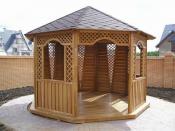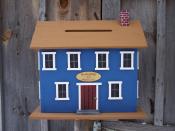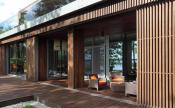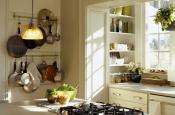Search
Login
Recommended
Installation of PVC wall panels, how to do it, useful tips
The popularity of PVC panels in construction is due to quite significant reasons. Attractive are their decorative capabilities, which consist in a variety of shades, patterns and textures, low cost, simple installation, which the owner of a house or apartment can do with his own hands. Installation of PVC wall panels will allow you to forget about the need for cosmetic repairs for a long time - compliance with the operating rules will allow them to maintain an attractive appearance for a long period.
Content
- Where are PVC panels used?
- Dimensions of PVC Wall Panels
- Preparation for work
- How to assemble the frame video
- Basic rules for the installation of plastic profiles and panels
- Installation procedure
- Recommendations for choosing PVC panels video
Where are PVC panels used?

Given the modern approach to finishing materials, it is somewhat difficult to imagine that plastic wall panels will be used to decorate a bedroom or living room, but in the corridor, in the kitchen, in the bathroom or on the veranda, they sometimes turn out to be simply irreplaceable. They are also often used for decoration of public and office premises.
A variety of external styles of models of their PVC panels allows them to be used in any style of decoration, and their moisture-proof properties represent them as ideal hygienic-approved finishes for bathrooms and toilets. No less valuable property of the panels is their ability to withstand the loads created by flooding the apartment by residents living on higher floors. Even in the event of a serious accident, the panels will not have to be replaced with new ones - they will easily be cleaned of impurities and will get their original appearance after drying.
Using wall panels for the kitchen, where fat and soot can settle, the PVC material will periodically be cleaned periodically with warm water and ordinary detergents.

Mold, fungi and bacteria cannot reproduce on the surface of the material.
Dimensions of PVC Wall Panels

Firstly, all manufactured panels can be divided by thickness into 5 mm and 8-10 mm. Sheets with a width of 100 mm usually have a length of 3 m, if the width of the sheet is from 200 to 370 mm, then its length can be 2.6 m, 2.7 m, 3.0 m.
By design, a lining with a width of 100 mm can differ in the width of the lock - in Europeans it is narrower, in Poland - wider. Lining with a width of 12.5 cm is distinguished by a double profile, it is found on sale quite rarely.
The panel material differs from the lining in the absence of connecting seams, the width of the panel can vary between 15 - 50 cm.
Preparation for work
As already mentioned, especially careful preparation of the walls before installation is not required. But you should measure the surfaces that will be sheathed with maximum accuracy and correctly calculate the amount of material for their sheathing.

In addition, you will need to decide how the installation will be carried out - if the walls and ceiling in the room turn out to be perfectly even, they can simply be glued with panels. But if the task is to give the room ideal parameters, then care should be taken to install the frame, the main advantage of this option is the ability to give the room an aesthetic appearance by hiding all engineering communications under the surface of the panel skin.
When performing work, you will need to use the following tools:
- comfortable step ladder
- drill or punch,
- hacksaw
- tape measure and level
- paint knife
- with a hammer
- self-tapping screws.
It is recommended to stock them in advance, otherwise it will fail to assemble accurately and efficiently. Having collected everything you need, you can begin to markup. For the ceiling, PVC panels with a width of 100 mm are usually used, the so-called lining. The lines for the installation of the profile should be marked every 0.4 m. First, the lowest point on the ceiling is determined, marks are made from it that correspond to the width of the panel. Then, using the level around the room’s perimeter, marks are applied at the points where the anchor or dowel will be attached with which the frame will be attached to the walls or ceiling.

The profiles of the supporting frame must be fixed perpendicular to the PVC plates attached to them. To simplify the marking process, experts recommend using a thin cord in addition to arranging marks and level. They rub it with colored chalk, press the ends to the wall to be marked - a color mark will remain along its entire length.
How to assemble the frame

The quality of the finish will depend on the correct assembly of the frame, which is a combination of profiles. As a profile, different materials can be used:
- wood,
- plastic crate
- metal.
Naturally, each of them has its own advantages, which determine the rationality of using the material under certain conditions. A wood frame, for example, is recommended for use in rooms with normal humidity, if this option is acceptable in a kitchen, then using it in a bathroom or on a balcony is unlikely to be appropriate. In any case, using natural and environmentally friendly wood material, it will be necessary to treat it with high-quality impregnation, which protects against the penetration of moisture and the development of fungi.

When mounting a wooden frame, the fastening of the beams is performed every 0.6 m, with dowels or impact screws. If you want to give the boards the desired level - use the lining. The wooden frame in its characteristics is slightly inferior to plastic or metal structures.
The use of U-shaped plastic profiles allows you to take advantage of the following advantages:
- low cost
- light weight
- simplicity of fixing work,
- ability to withstand the effects of moisture, steam, temperature extremes.
Installation of the profile is carried out every 0.3 m, respectively pre-drawn lines. Fixing dowels or self-tapping screws used during installation are installed after 1 m. Docking of the profile is carried out at an angle, it must be controlled so that the joints are smooth, with well-fitting profile surfaces.
As an advantage, the possibility of using profile grooves for laying an electric cable can be noted.
PVC wall panels are lightweight and do not require a particularly powerful frame. If, nevertheless, it is decided to mount the metal crate, then the cable will have to be laid in special corrugated PVC pipes - this will eliminate the possibility of damage to the power cable braid by the sharp edges of the frame profile.
Basic rules for the installation of plastic profiles and panels
When installing a PVC profile, the following rules should be followed:
- installation should begin after the material has passed adaptation to the room temperature, especially if it was stored in a room with a temperature below +10 C,
- the lamellas should be placed perpendicular to the direction of the frame rails,
- if there is increased humidity in the room, then ventilation cuts are made in the frame,
- do not forget about the need for 5 mm compensation gaps, taking into account the possibility of changing material parameters with increasing temperature,
- installation of panels without a picture is performed arbitrarily, if there is a picture on the surface - work starts from the left corner and moves to the right,
- it is impossible to plan the installation of PVC structures and use them as decoration in rooms with temperatures above +40 C, such as bath or steam rooms.
Installation procedure

ceiling

Directly to the installation of panels you can start after the completion of the construction of the frame. Installation begins from the extreme strip, it is fixed in the corner, to the transverse profile using self-tapping screws. Each next panel will be inserted into the groove of the previous one. The procedure will be repeated until the finish reaches the opposite wall. If necessary, the last panel is cut in width. But you can do it another way: turn the panel so that the mounting lock is on the other side, then cut the groove from the side.
Since the material is brittle, the use of sharp external influences on it can lead to the appearance of cracks on the surface, they cannot be eliminated.
When applying panels during installation, special efforts should not be applied to them. If necessary, an office knife can be used as a tool at hand, the edges of plastic panels can be guided with its narrow blade.

After completing the installation of the last panel, you can proceed with the installation of the skirting board. For its fastening, liquid nails are used, they are applied to the inside. Then the baseboard is pressed tightly against the finished surface of the ceiling and held for 10 seconds. Glue residue is carefully removed.
Since the solidification of liquid nails occurs very quickly, you should hurry with the removal of sag.
wall decoration

Using PVC wall panels for a bathroom or toilet, owners of a house or apartment get the opportunity to quickly and easily arrange a practical and reasonably comfortable interior in plumbing rooms. The process of wall decoration has almost the same technology that is used when installing the ceiling.
A frame made of plastic or metal profile is mounted on a wall treated with an antifungal primer. Installation of the first panel is carried out by inserting it together with a corner into the profile, the subsequent ones are inserted into the grooves of the previous ones and fixed on metal guides with the help of clamps. The last panel on the wall is installed in a U-shaped corner and is attached to the frame with it. Next, work is carried out to install the corners.
Some difficulties may arise when performing installation work on walls, where installation of switches and sockets is required. Before installing the tiles in this case, install the ducts and lay the electric cable. When installing the panels, it will be necessary to cut holes of the appropriate size in the marked places for installing outlets.
Recommendations for choosing PVC panels

- When buying PVC plates, you should make sure that there are no curved transverse stripes on them, the color of the material should be uniform, and no physical defects should be observed on the surface. It is good if the surface of the panels is protected with a special film.
- Acquired panels should have the same shade or plain pattern, they should not have areas with a blurry pattern or poor-quality painting.
- You should make sure that there are a sufficient number of stiffeners inside the panel - a large number of them can ensure the strength of the material and resistance to pressure loads.
- When trying to connect the panels, gaps should not form, the surface at the junction should look like a monolith.
- You should not purchase materials that at the joint give a different disclosure - at one end of the seam it can be 1 mm, at the other - up to 4 mm.
- Refrain from buying panels on the surface of which there are waves and stiffeners are visible - this is evidence of poor quality.
- It is not recommended to buy material from another batch even if the article matches.





